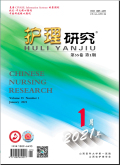护理研究2024,Vol.38Issue(14):2484-2489,6.DOI:10.12102/j.issn.1009-6493.2024.14.006
异基因造血干细胞移植输血不良反应风险预警模型的构建及验证
Construction and validation of risk prediction model of adverse blood transfusion reaction after allogeneic hematopoietic stem cell transplantation
摘要
Abstract
Objective:To explore the risk factors of adverse blood transfusion reaction after allogeneic hematopoietic stem cell transplantation(allo-HSCT),establish a risk prediction model and validate it.Methods:A total of 115 allo-HSCT patients in our hospital were selected as the study subjects from January 2018 to February 2023,then they were divided into modeling group(73 cases)and validation group(42 cases).The general information of the patient was investigated,C-reactive protein(CRP),albumin(ALB),neutrophils,lymphocytes in the patient's serum were tested,and CRP/ALB and neutrophil/lymphocyte ratio(NLR)were calculated.Single factor analysis and Logistic regression analysis were used to screen the risk factors of allo-HSCT adverse blood transfusion reaction,risk prediction model was constructed and transformed into risk scoring system.The differentiation and calibration of the evaluation model were conducted by receiver operating characteristic(ROC)curve and the Hosmer-Lemeshow(H-L)test,and the model was verified.Results:The levels of CRP/ALB and NLR in adverse blood transfusion reaction group were higher than those in without adverse blood transfusion reaction group(all P<0.05).Logistic regression analysis showed that the number of blood transfusio≥3 times,had the history of primary blood disease,had blood transfusion history,had allergy history,the patient's basic temperature≥38℃,the time from blood distribution to blood transfusion≥30 min,infusion rate of red blood cells≥50 drops per minute,platelet infusion rate≥90 drops per minute,CRP/ALB≥0.90,and NLR≥1.37 were risk factors for allo-HSCT adverse blood transfusion reaction.The area under the curve(AUC)of receiver operator characteristic of the model group was 0.841,and the H-L test result showed P=0.856.The sensitivity of the model was 0.909,the specificity was 0.775,and the Youden index was 0.684.The area under the curve of the validation group was 0.798,the H-L test result was P=0.813,the sensitivity was 0.818,the specificity was 0.775,and the Youden index was 0.593.Conclusions:The risk prediction model of allo-HSCT adverse blood transfusion reaction constructed in this study has high predictive effect and can provide targeted guidance for the nursing of allo-HSCT adverse blood transfusion reaction in clinical practice.关键词
异基因造血干细胞移植(allo-HSCT)/C反应蛋白/白蛋白(CRP/ALB)/中性粒细胞/淋巴细胞比值(NLR)/输血/不良反应/预警模型/护理Key words
allogeneic hematopoietic stem cell transplantation,allo-HSCT/C-reactive protein/albumin,CRP/ALB/neutrophil/lymphocyte ratio,NLR/blood transfusion/adverse reactions/risk prediction/nursing引用本文复制引用
张燕,季玲,顾伟英..异基因造血干细胞移植输血不良反应风险预警模型的构建及验证[J].护理研究,2024,38(14):2484-2489,6.基金项目
2023年度"龙城强医"医学重点学科市级基金项目,编号:KY20231531 ()

